
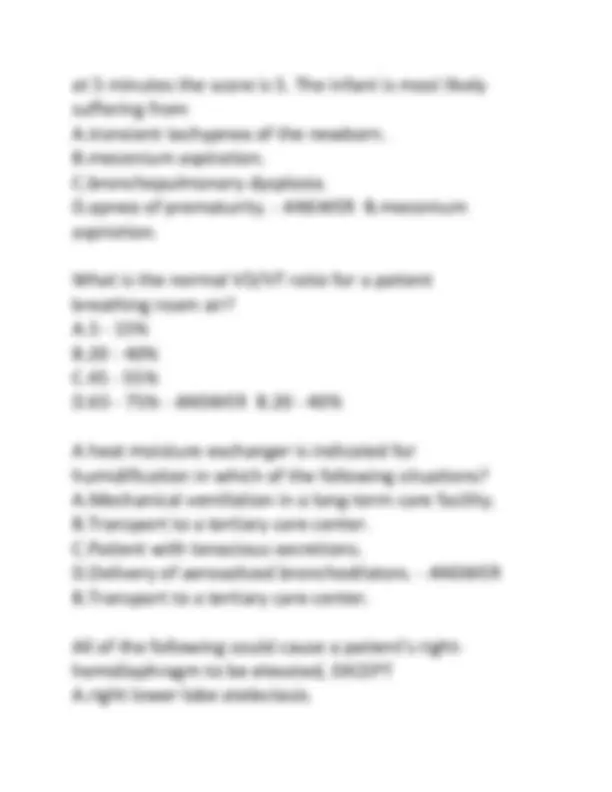
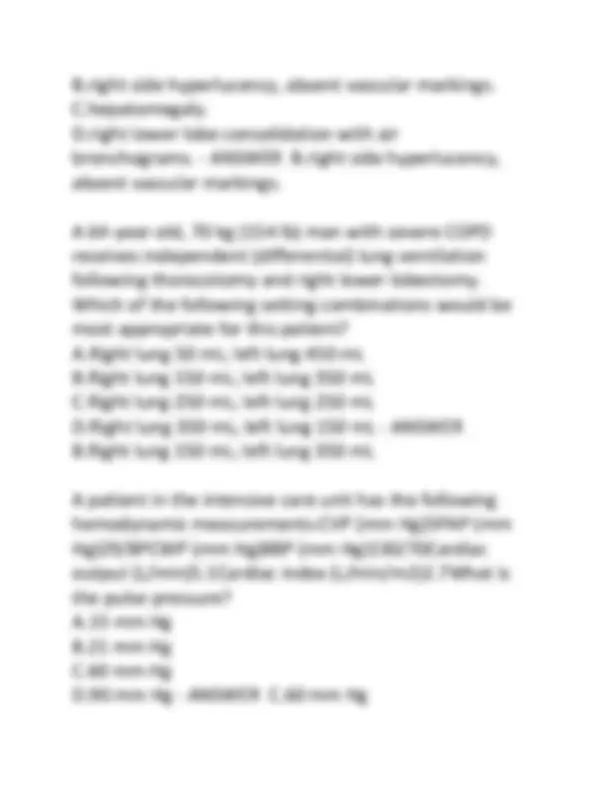
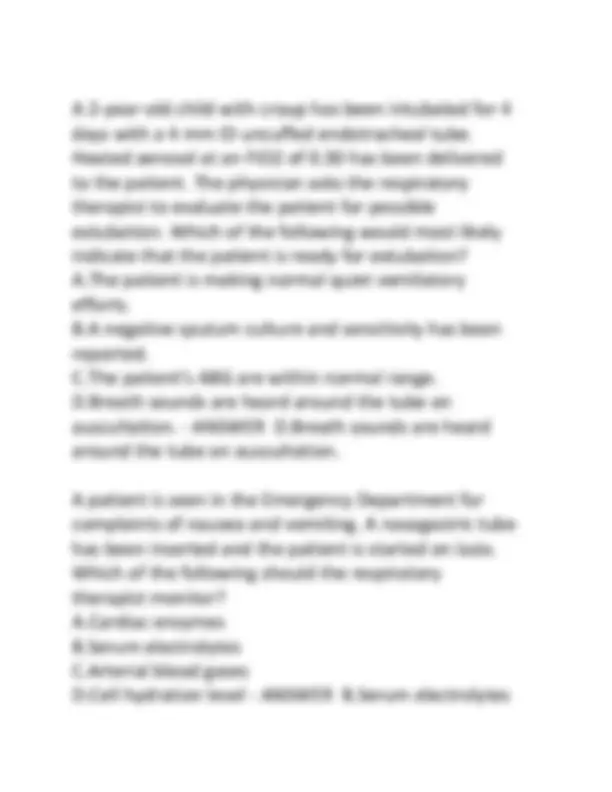
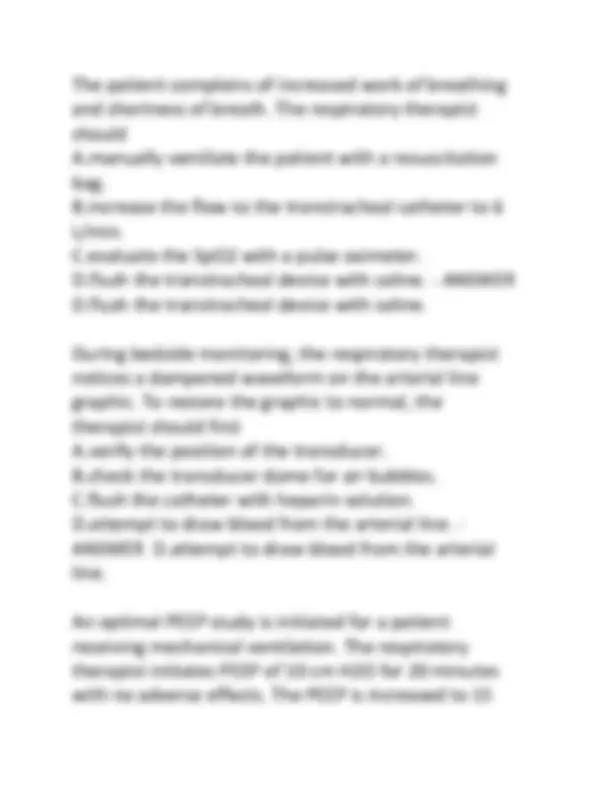
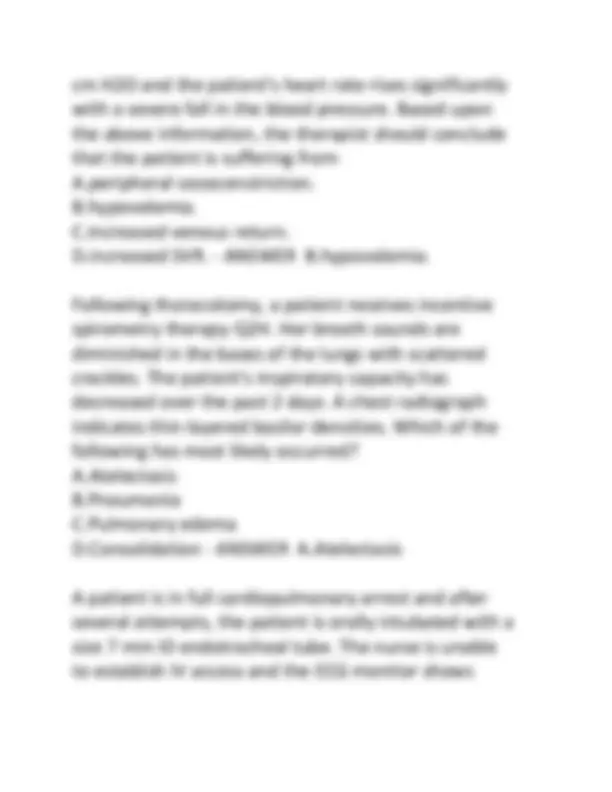
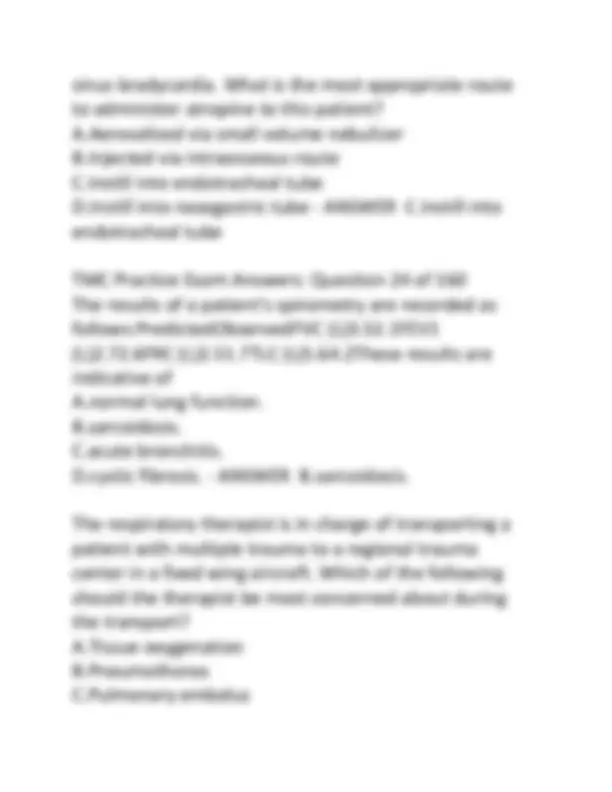
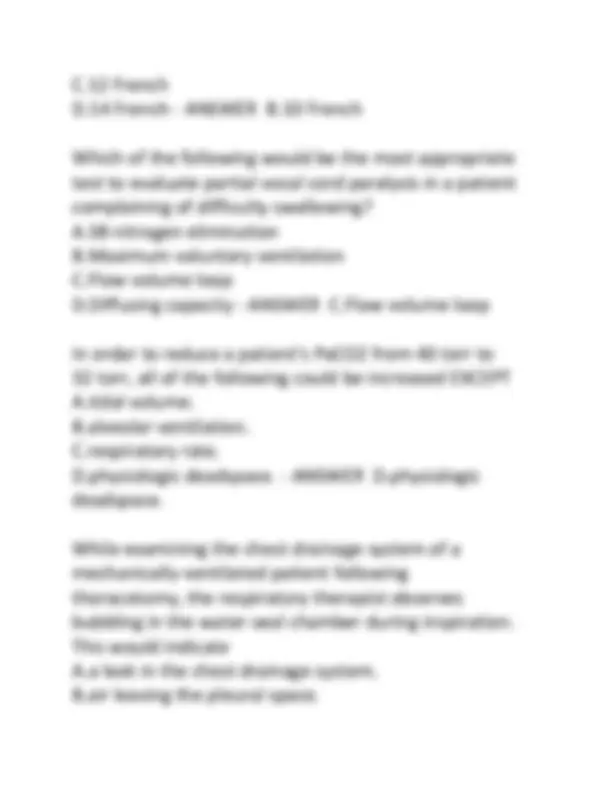
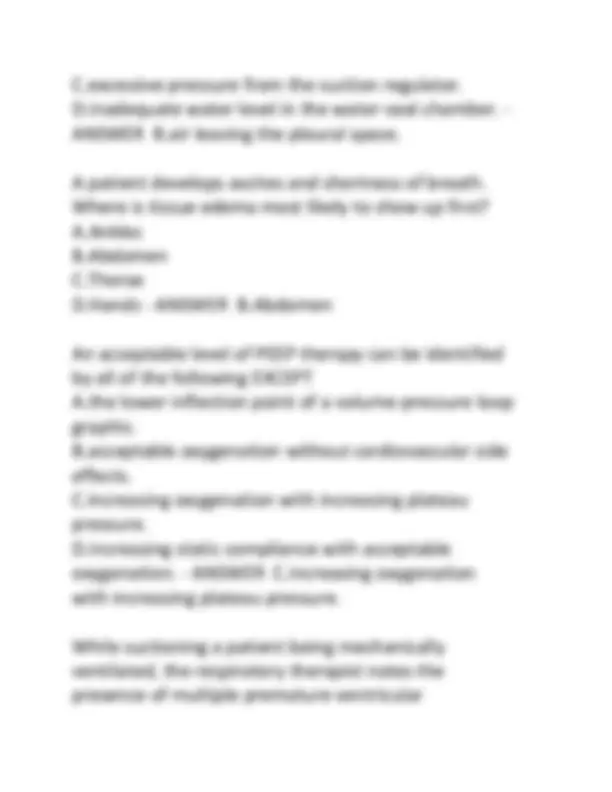
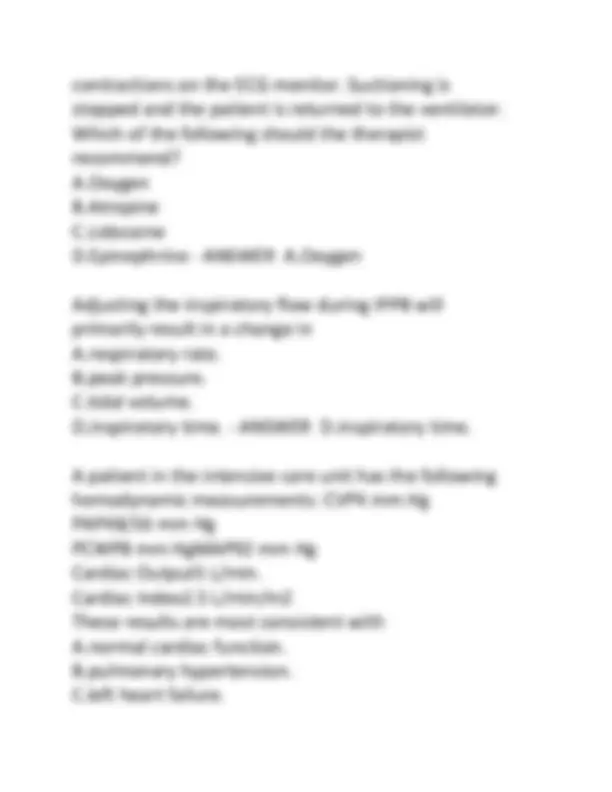
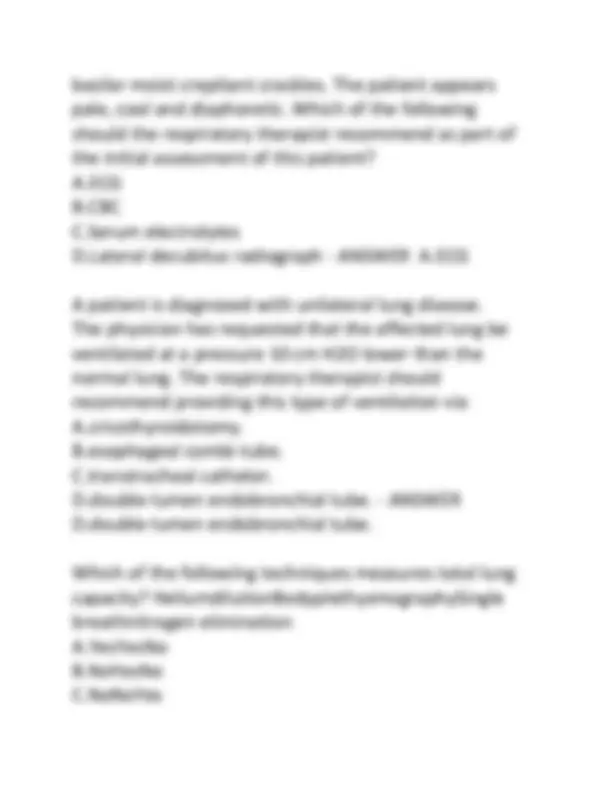
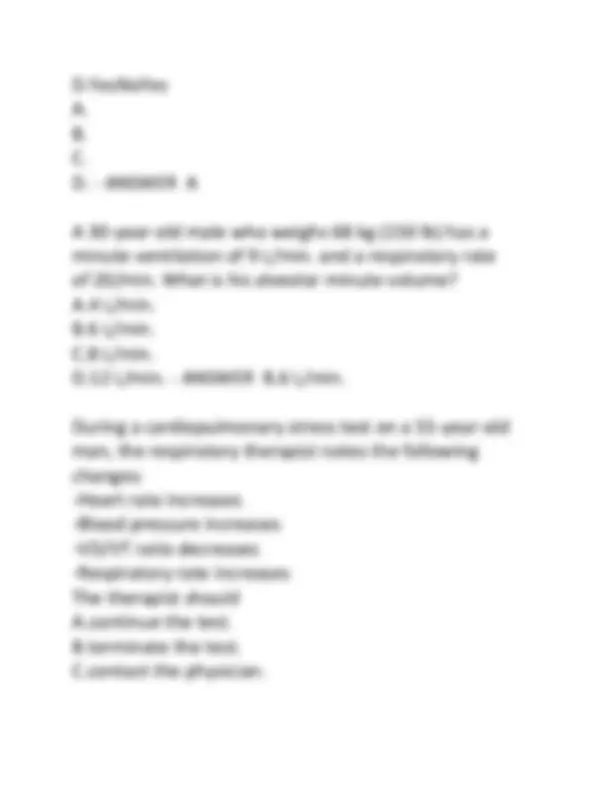
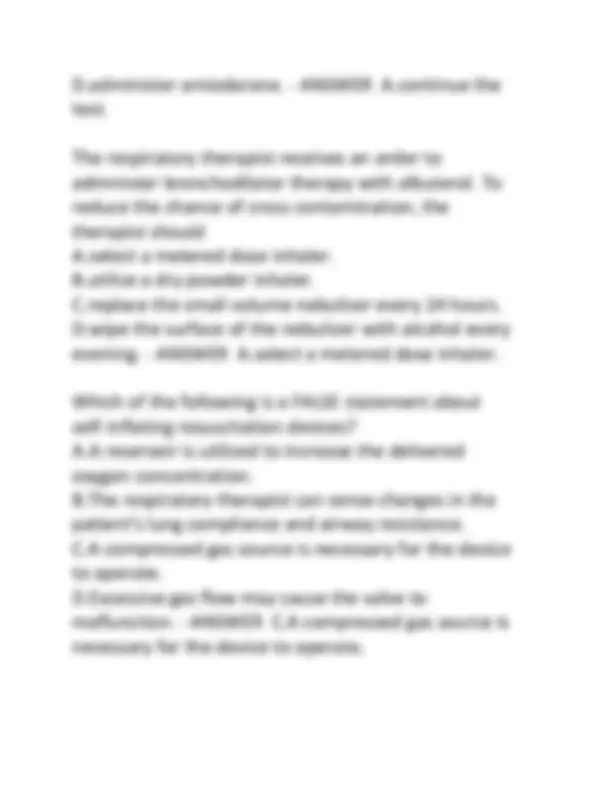
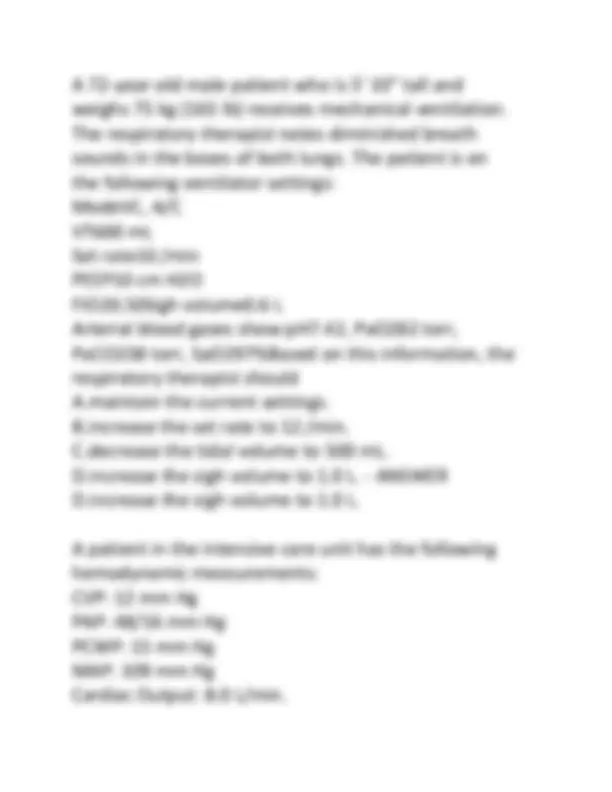
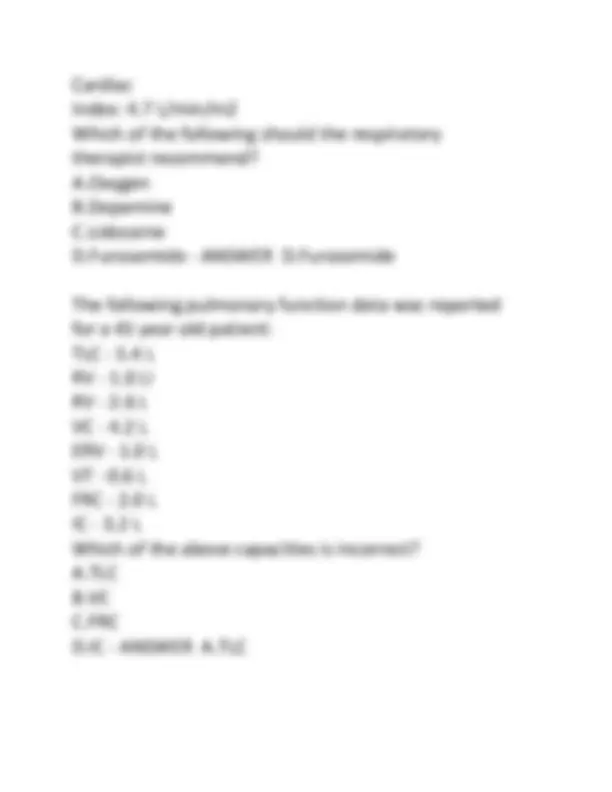
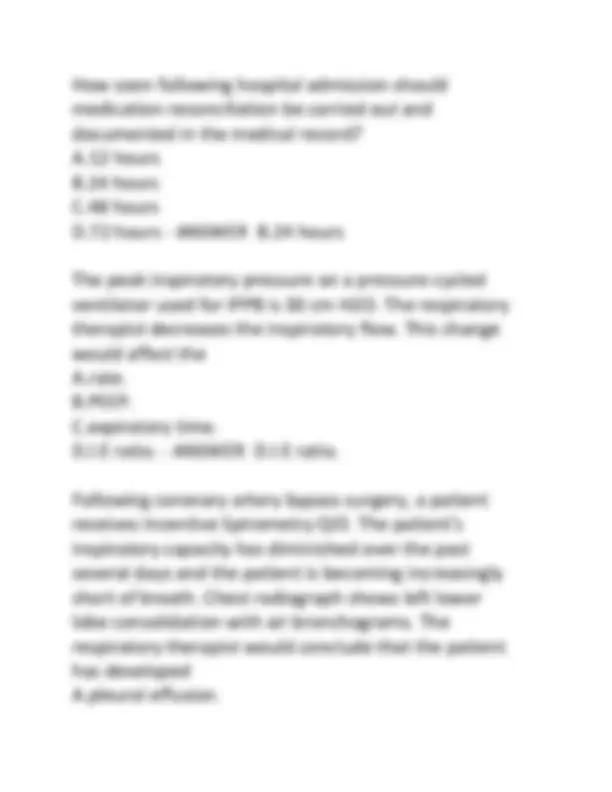
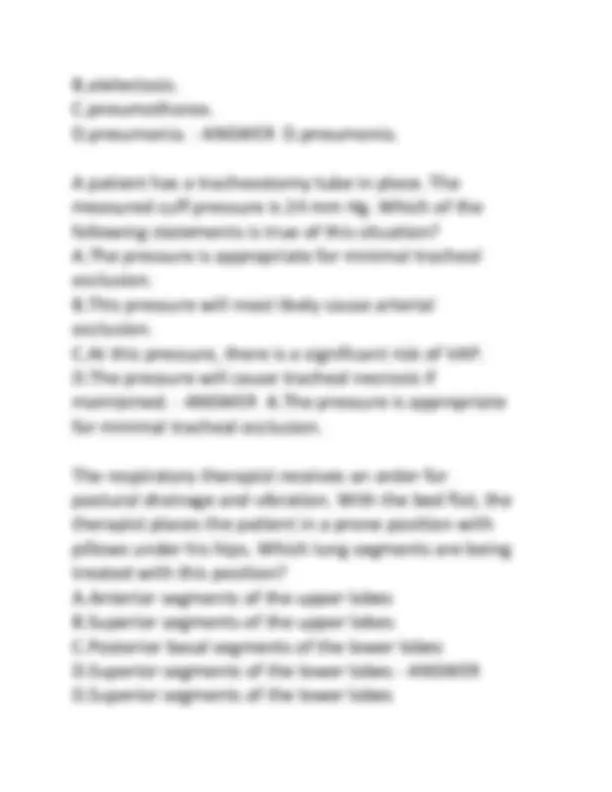

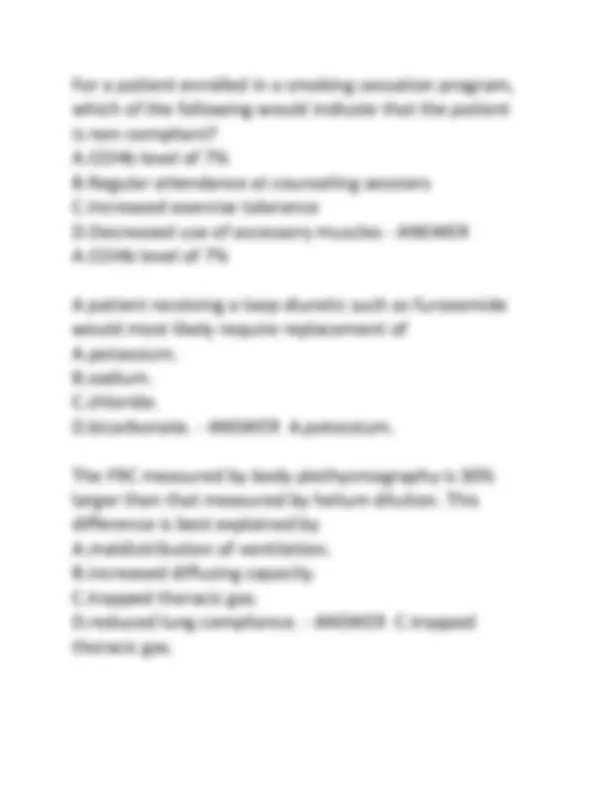
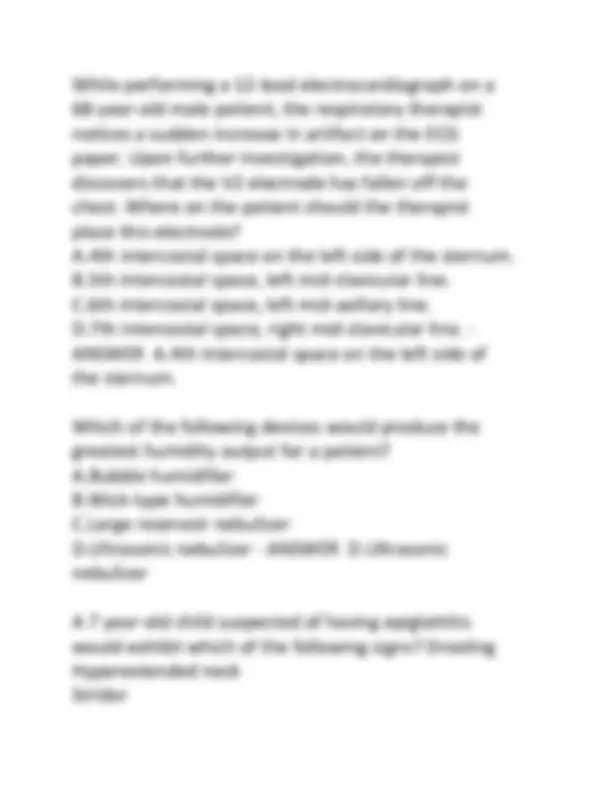
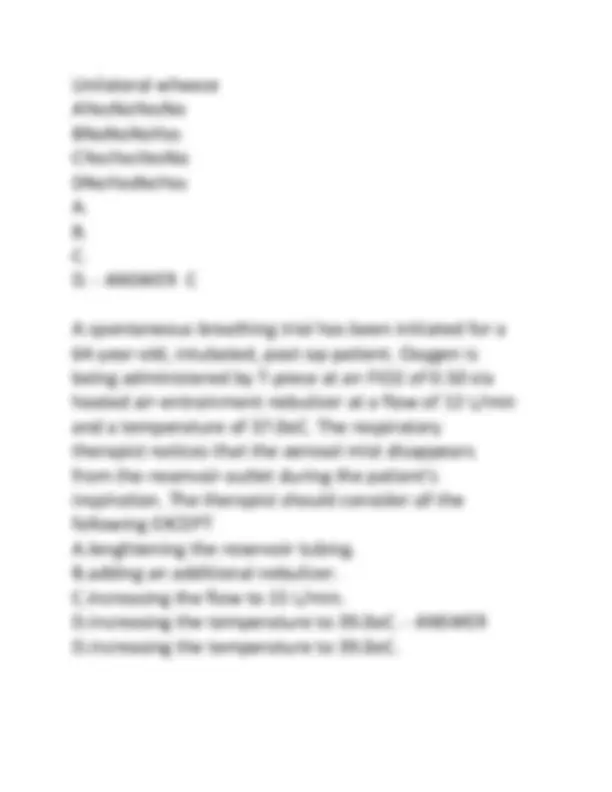
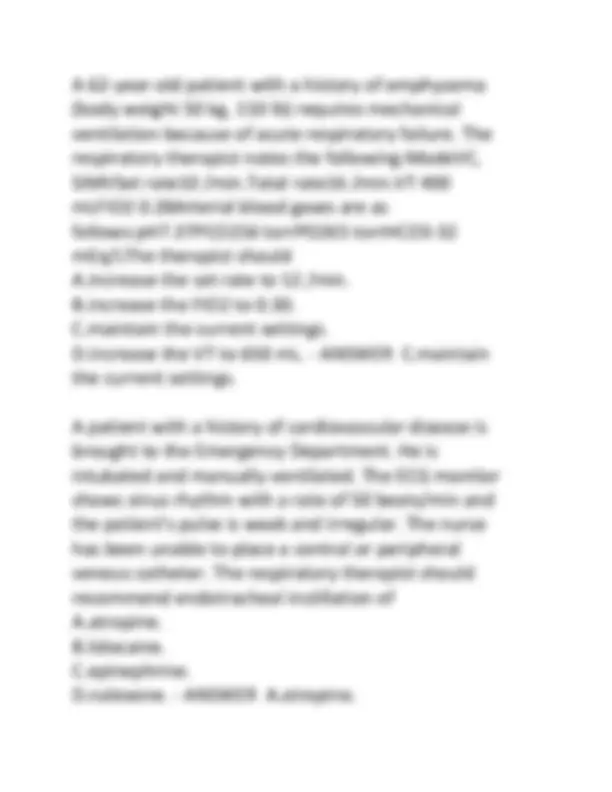
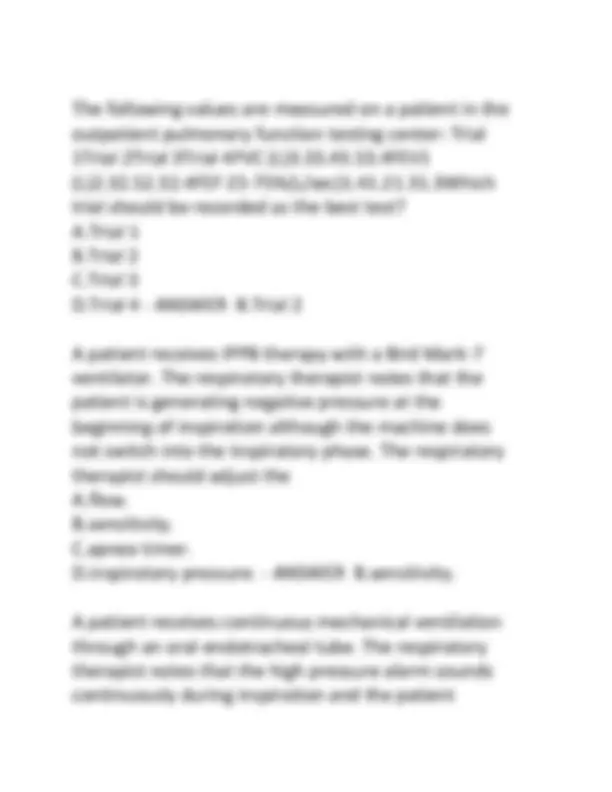
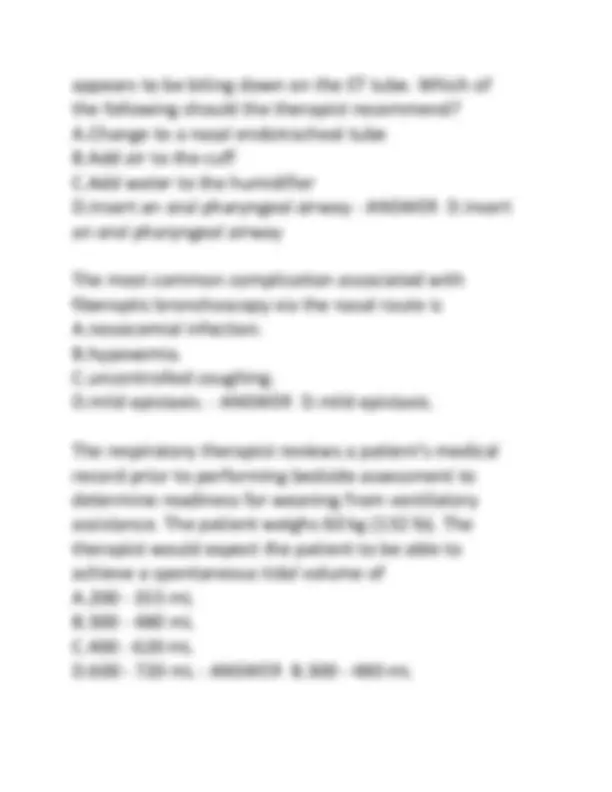
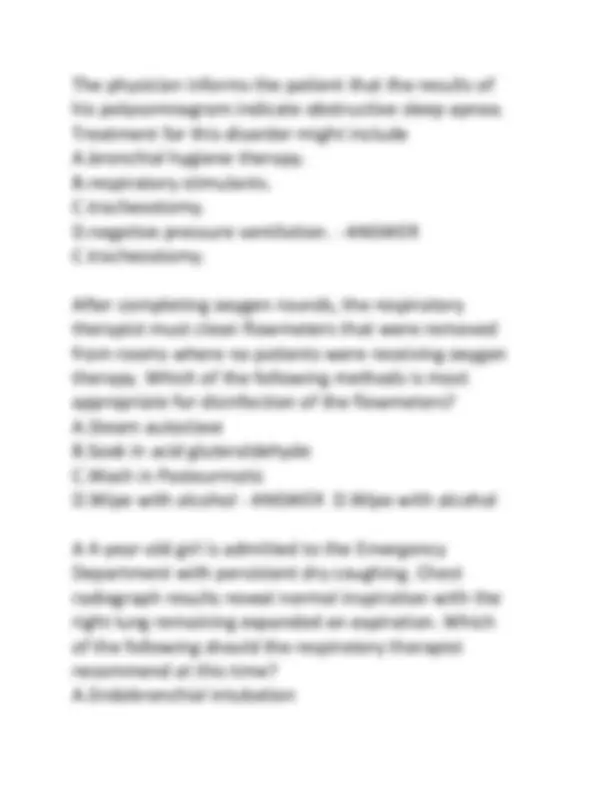
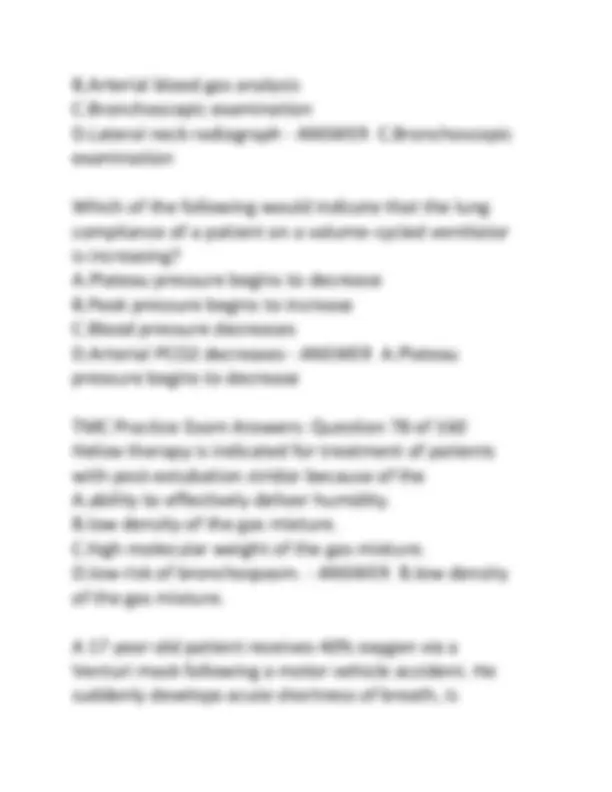
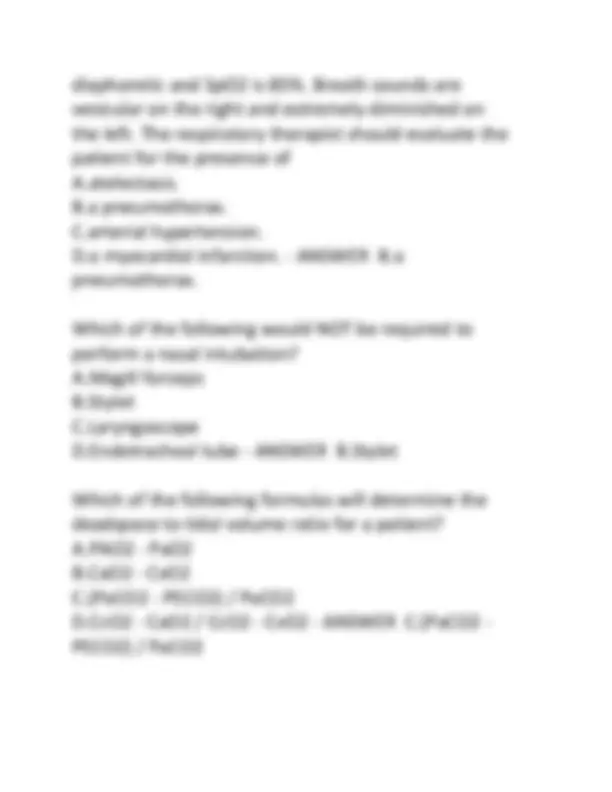
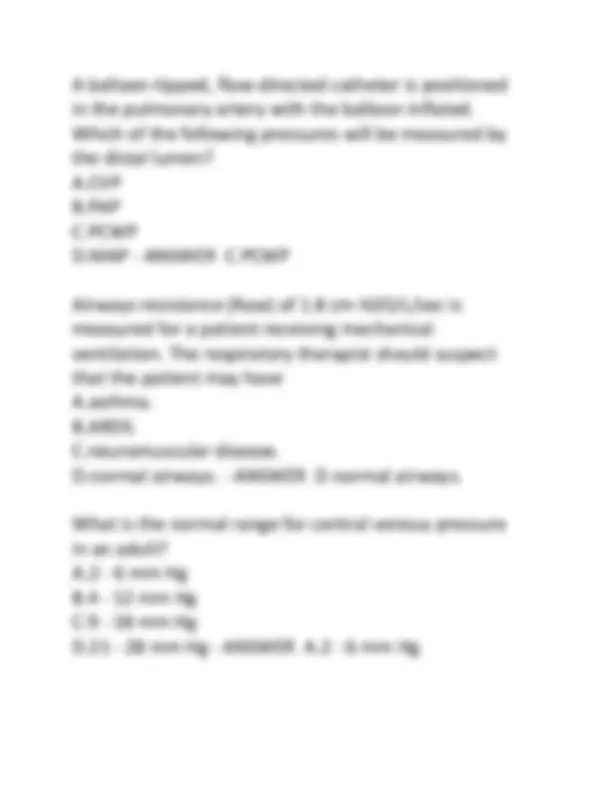
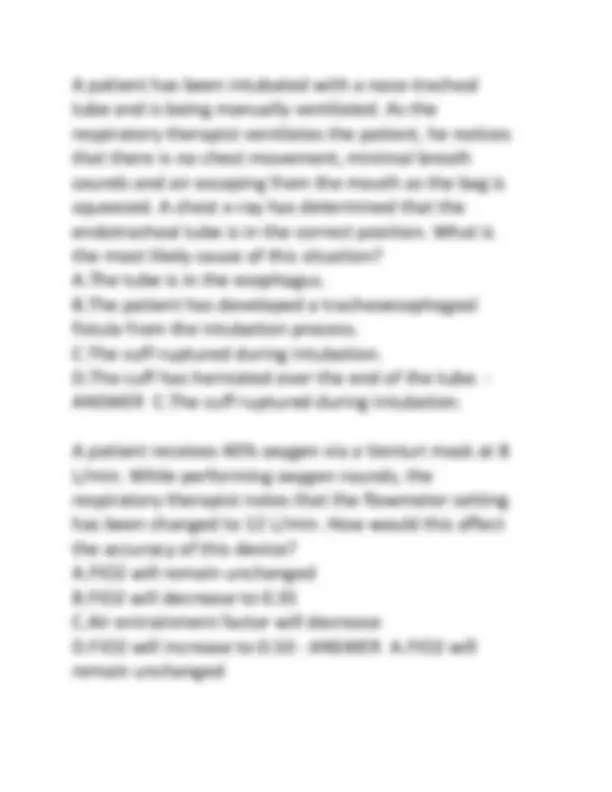
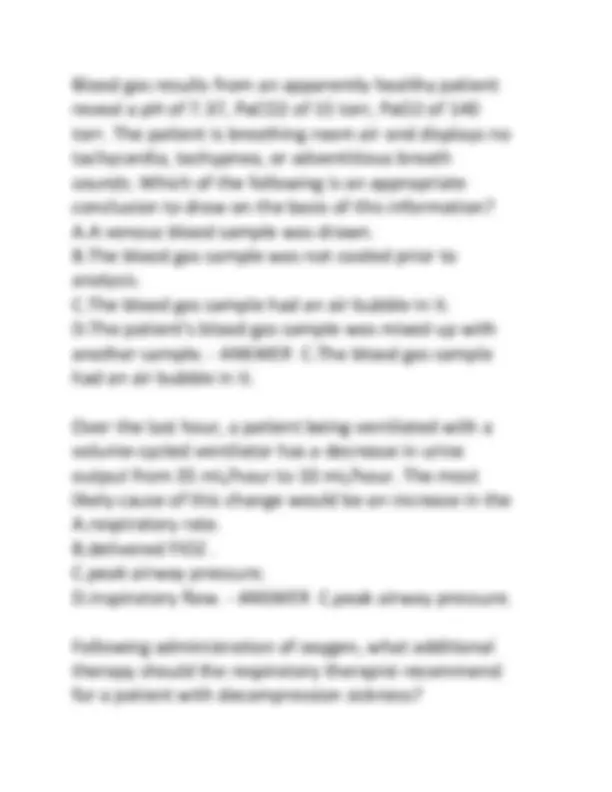
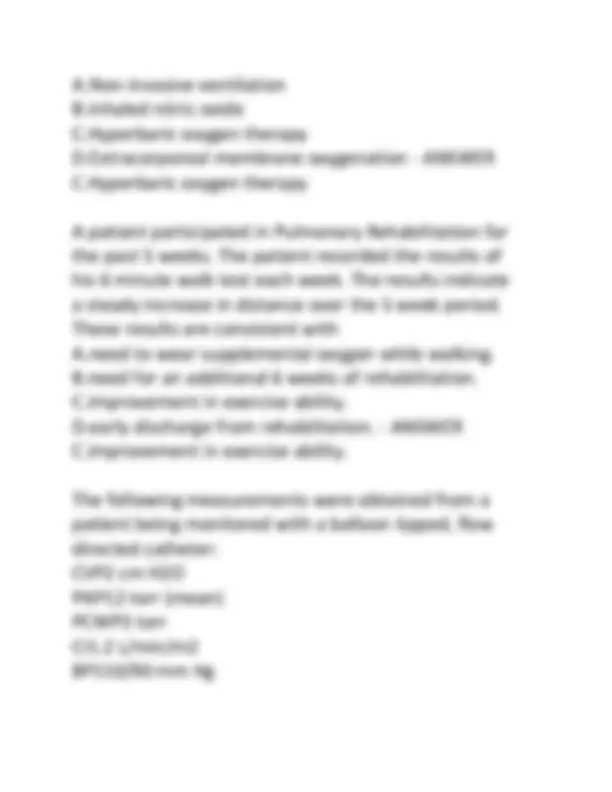
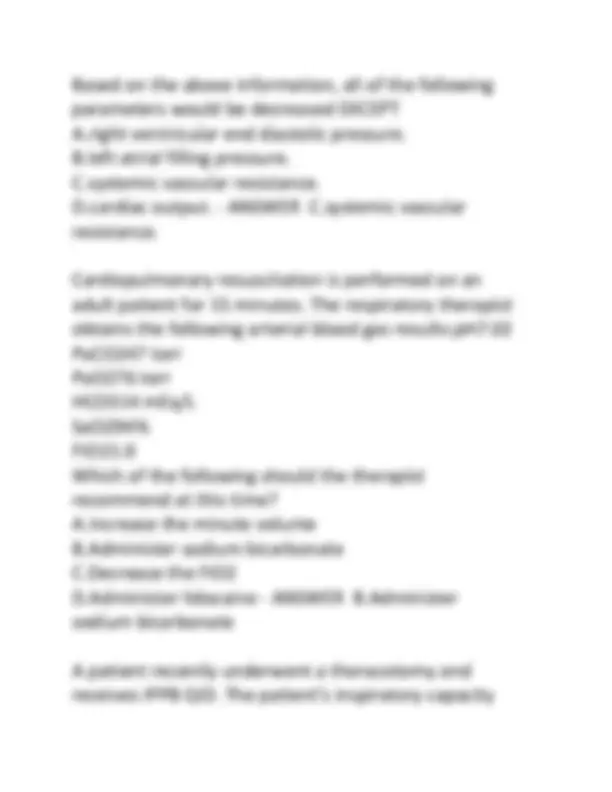
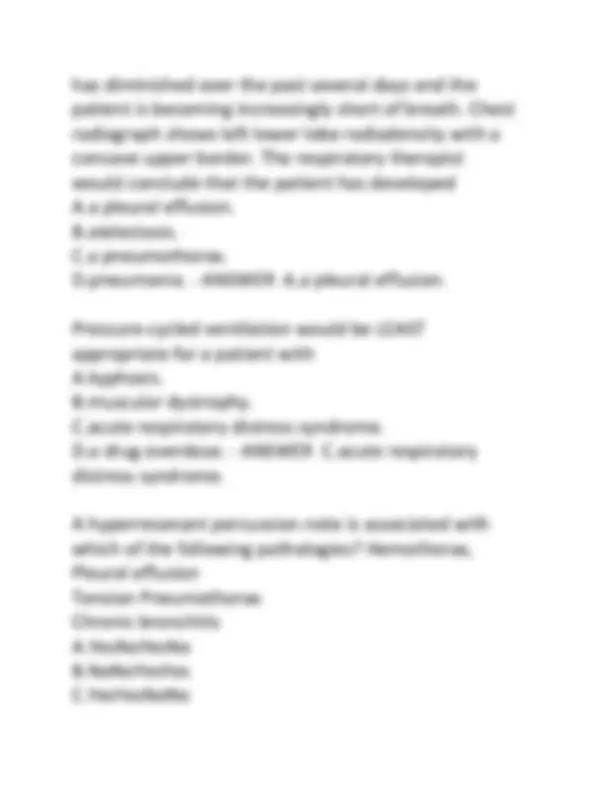

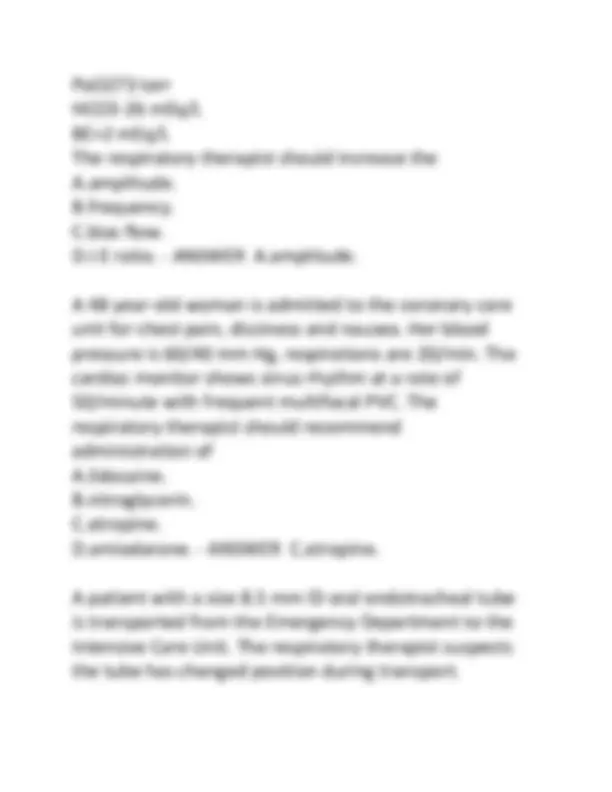
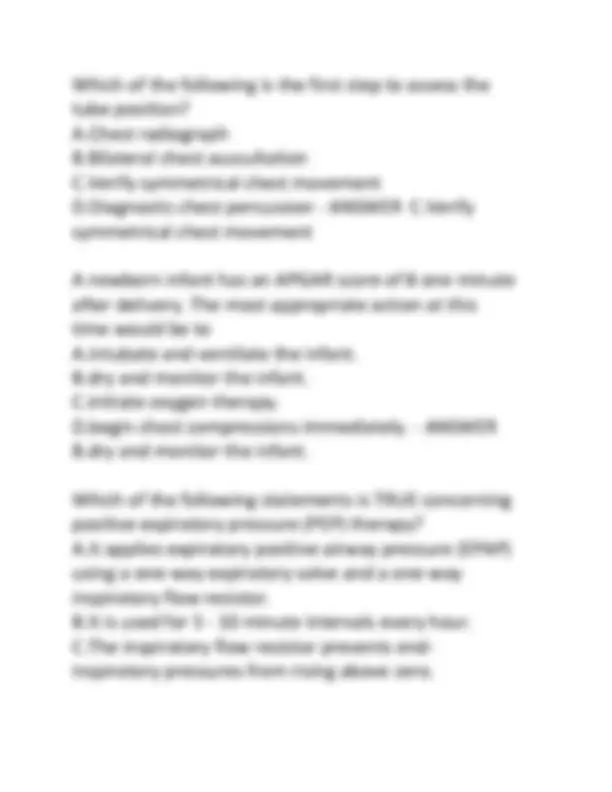
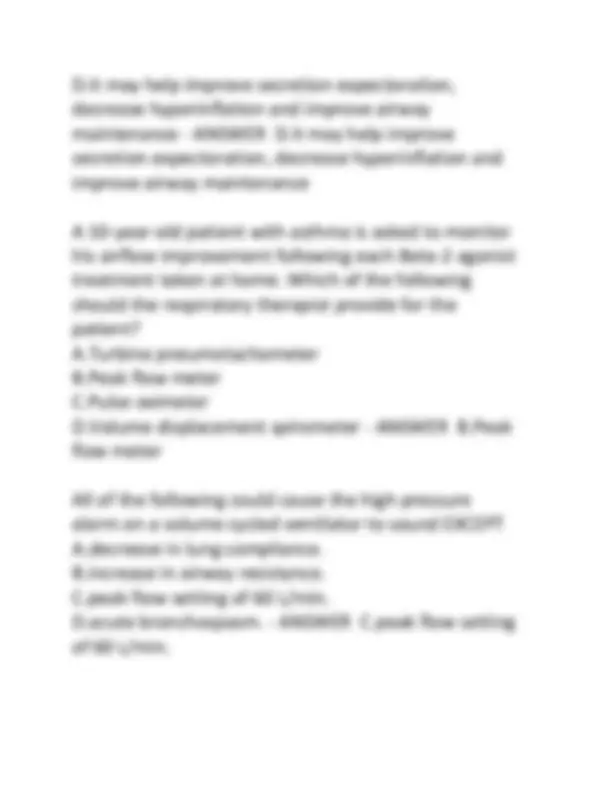
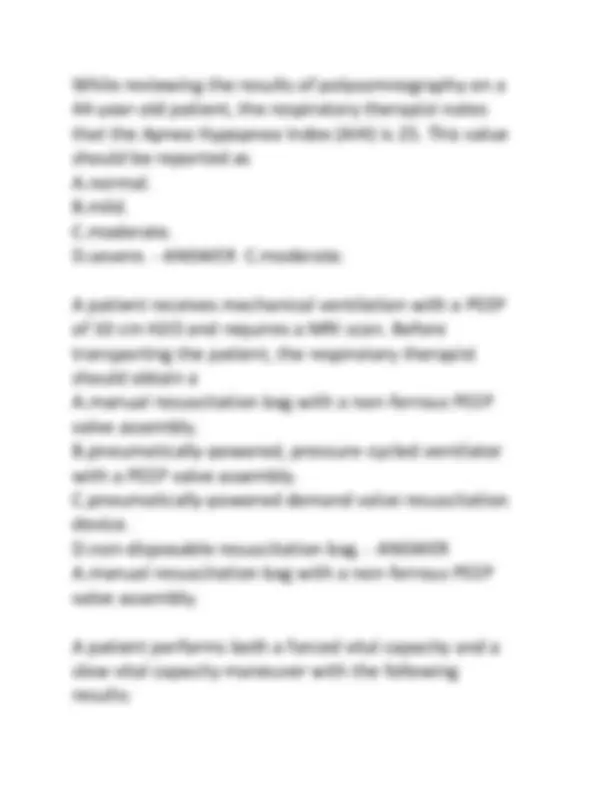
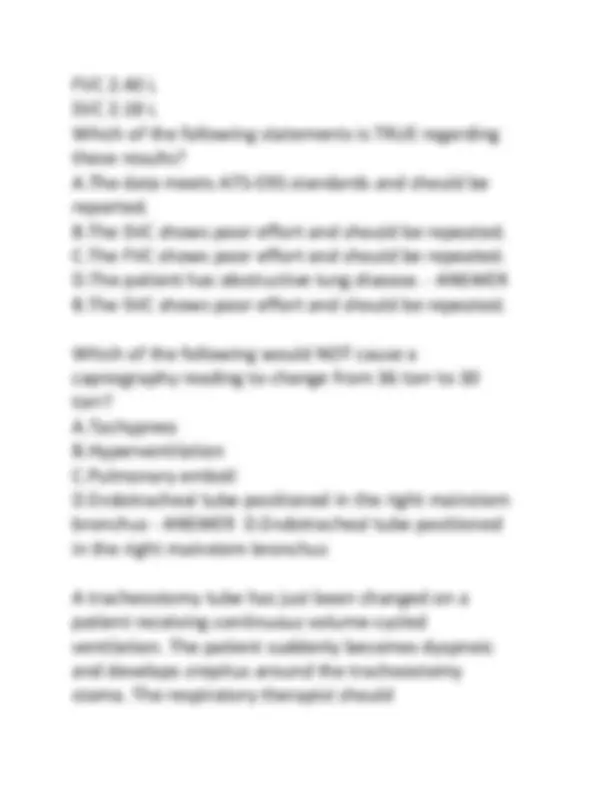
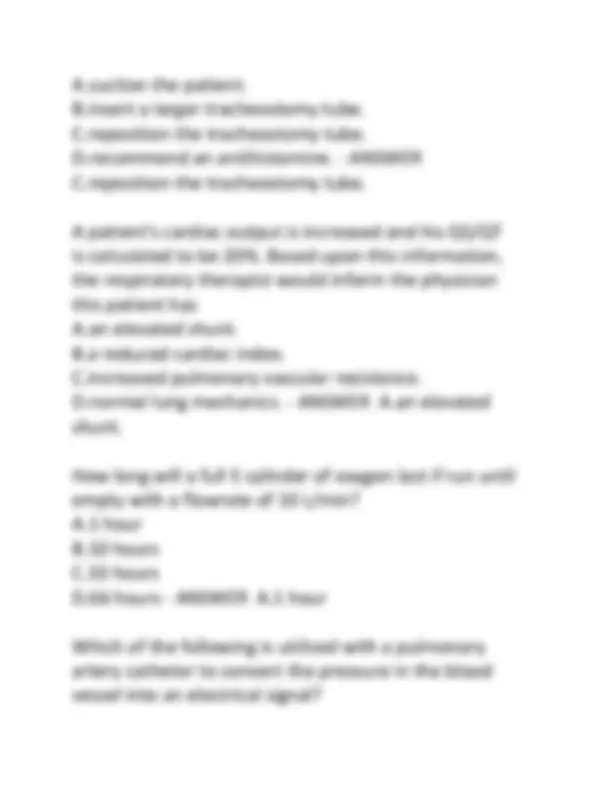
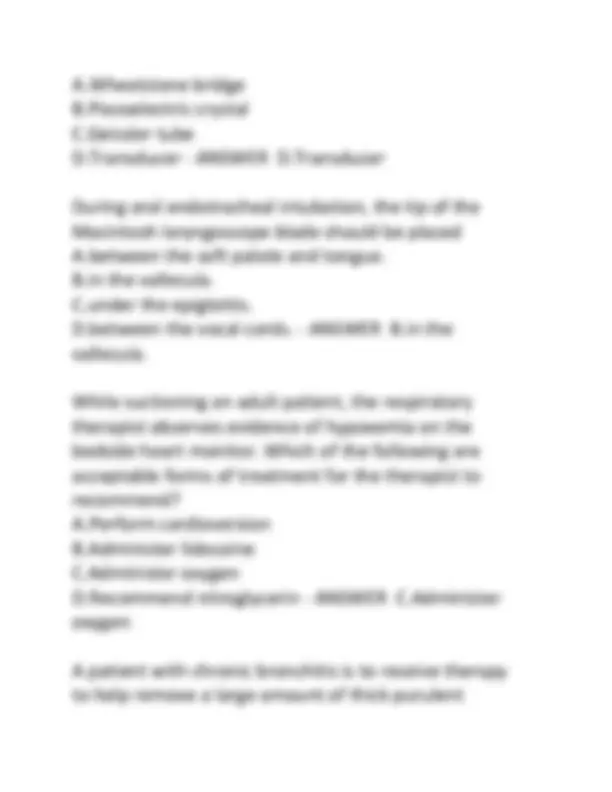
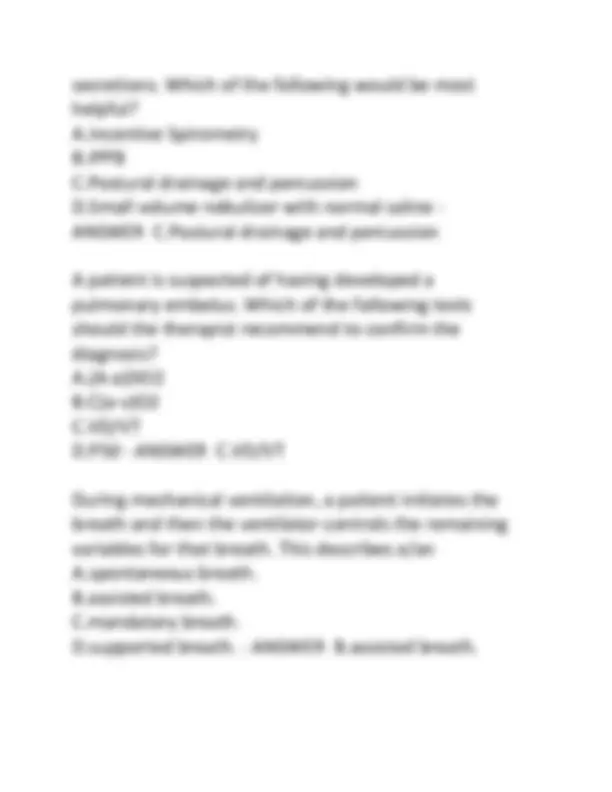
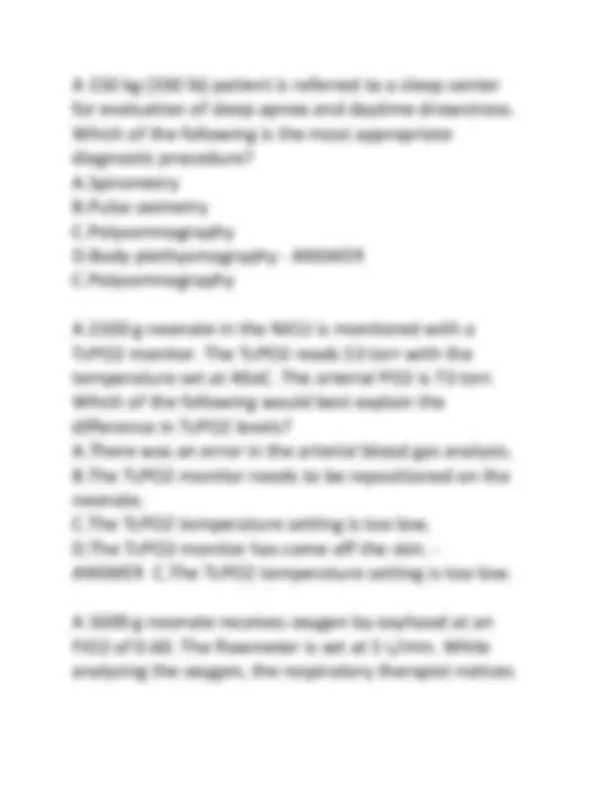
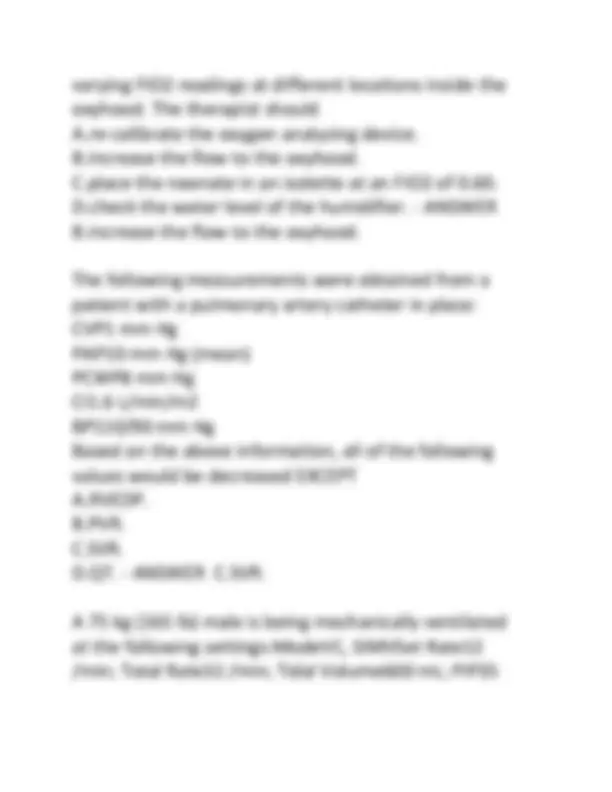
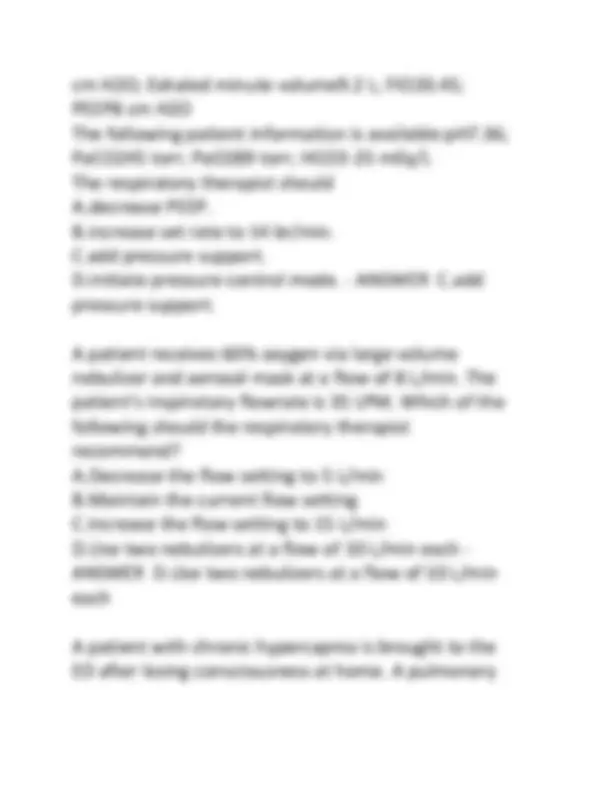
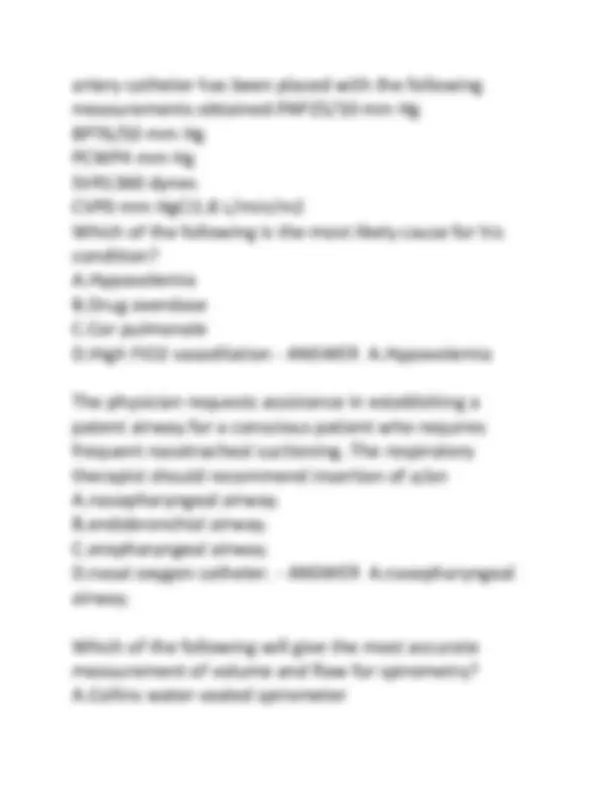
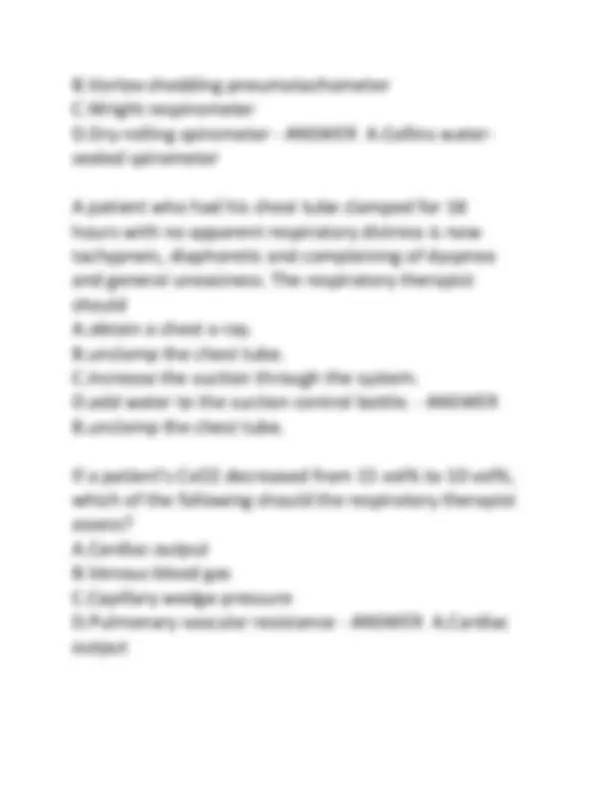
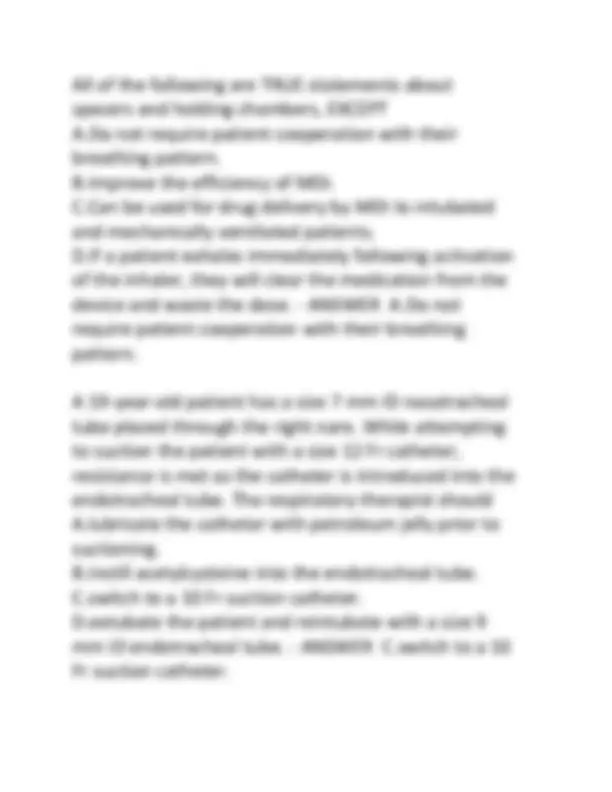
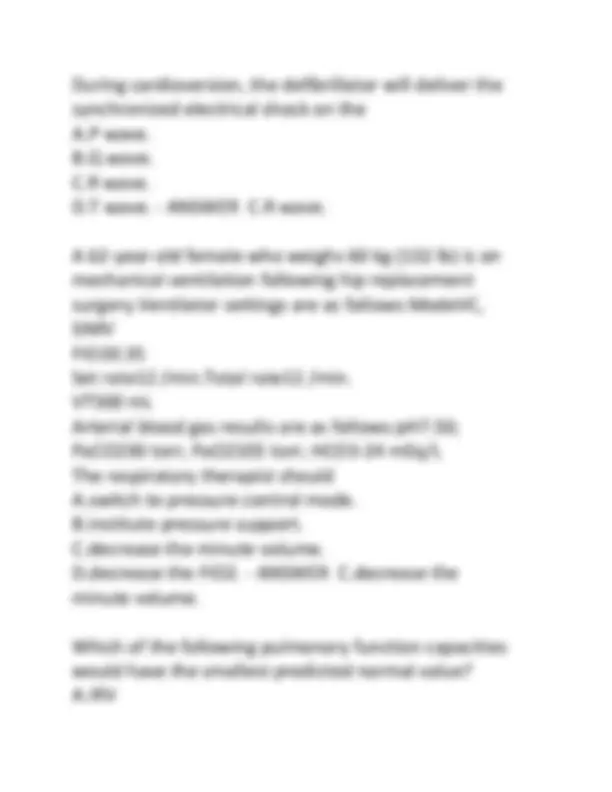
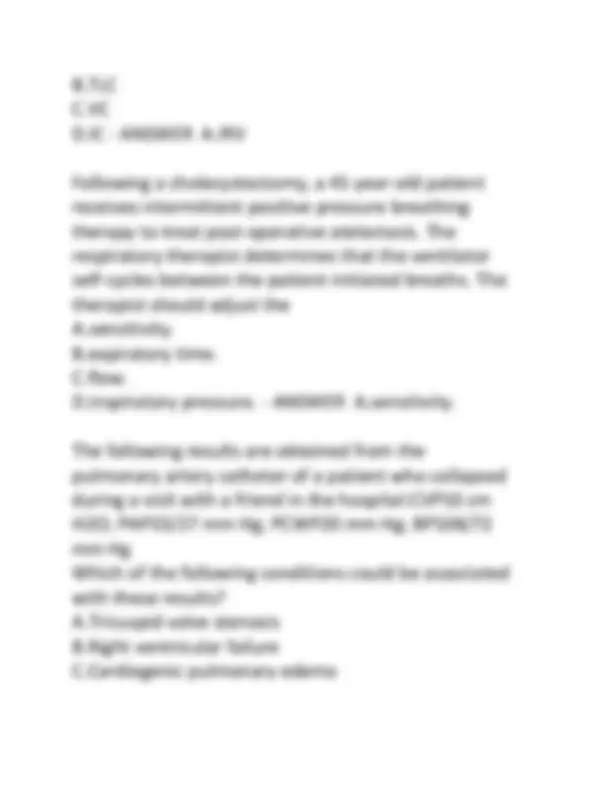
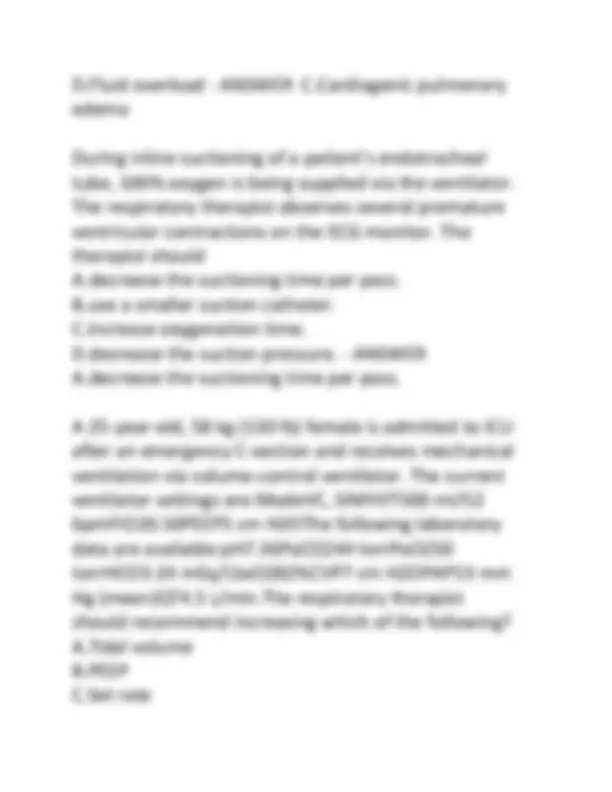
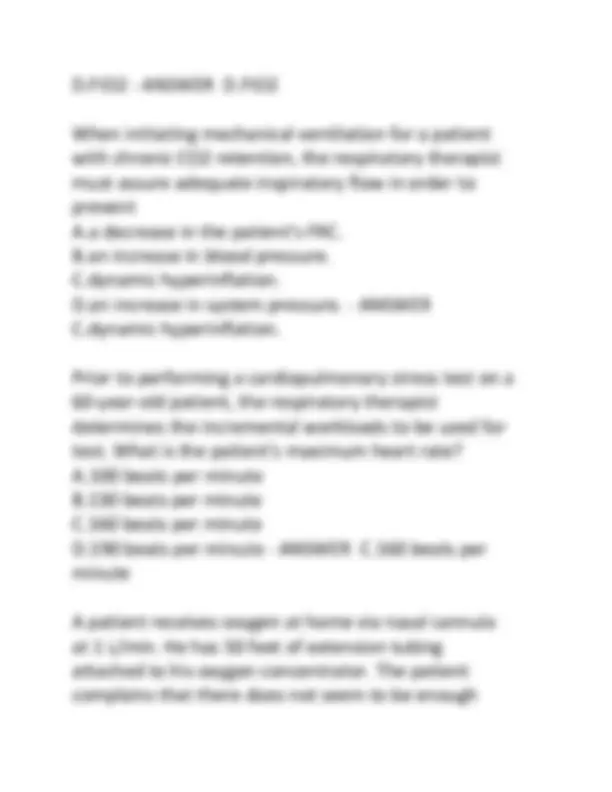
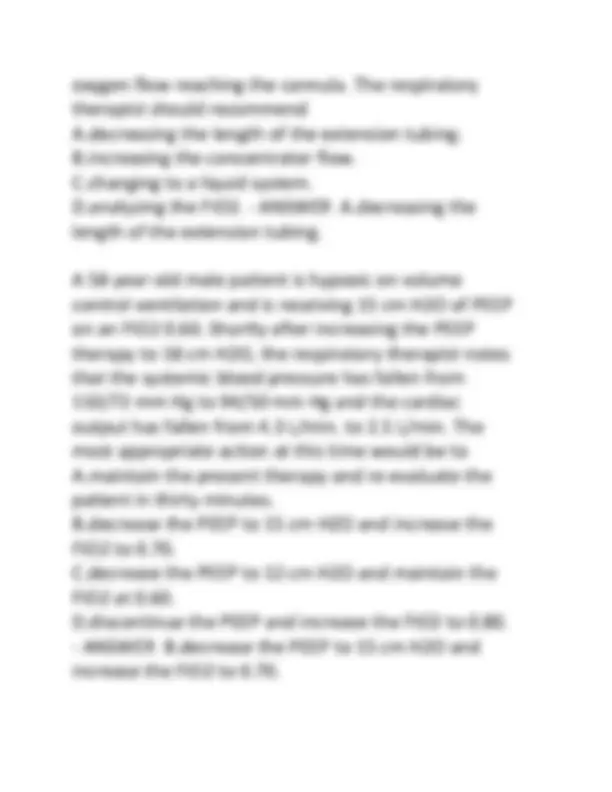
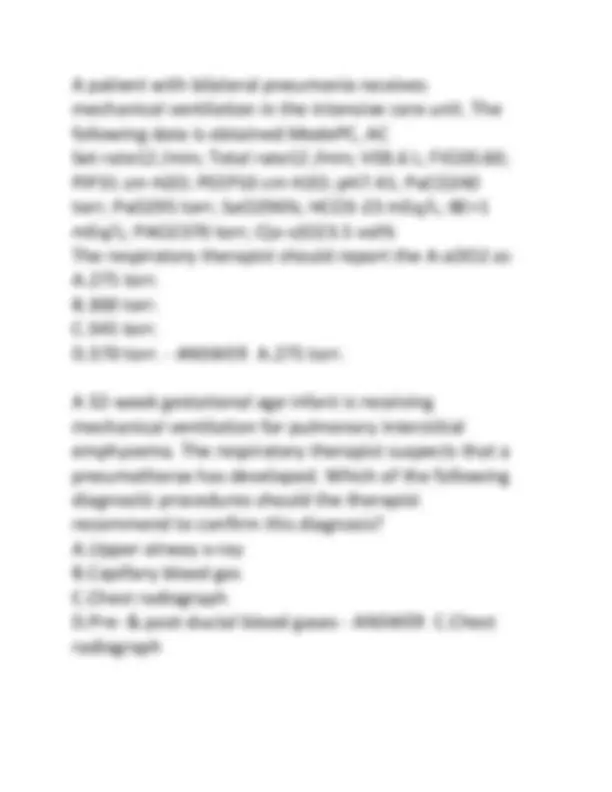
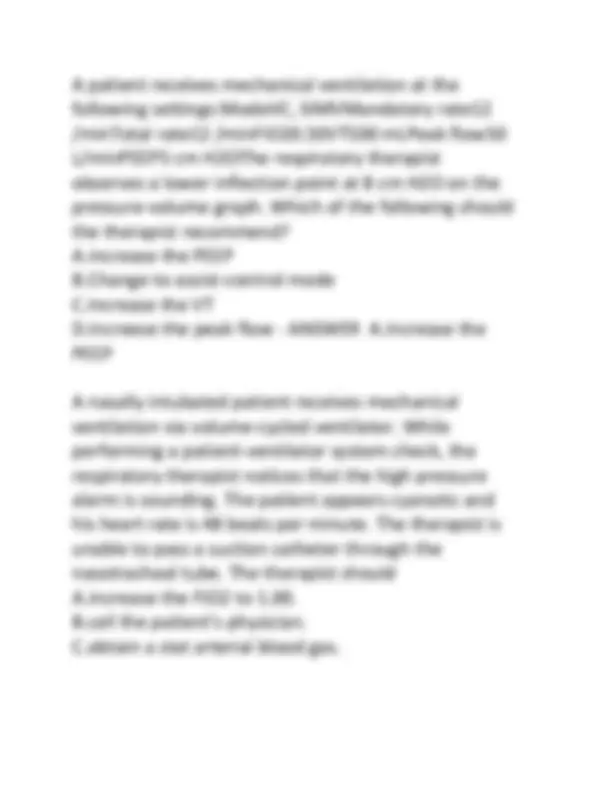
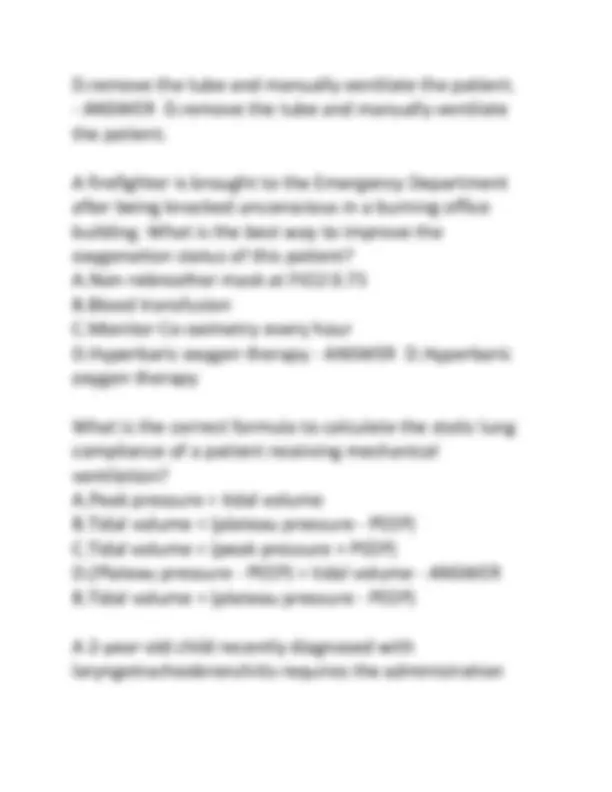
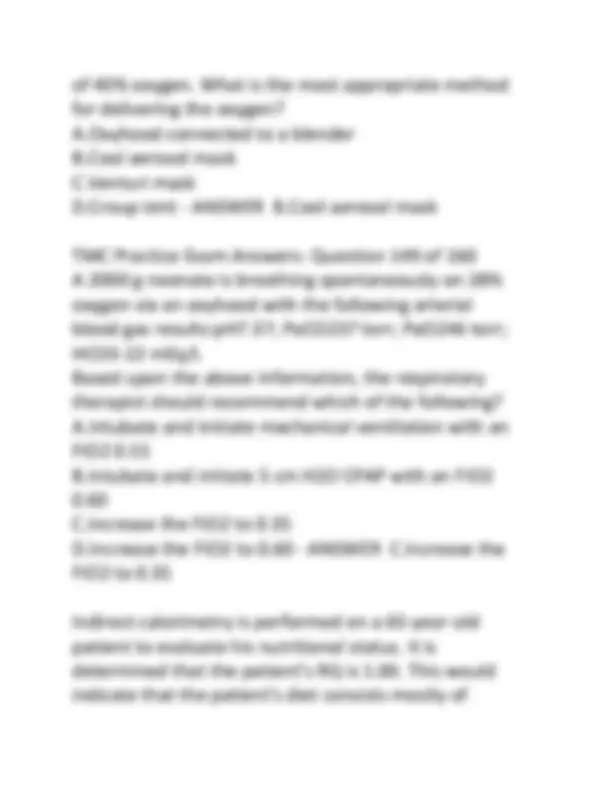
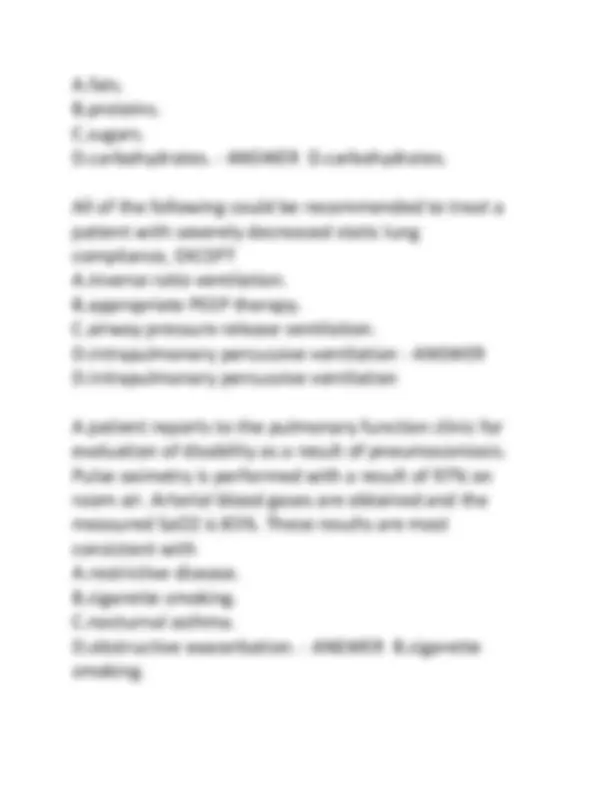
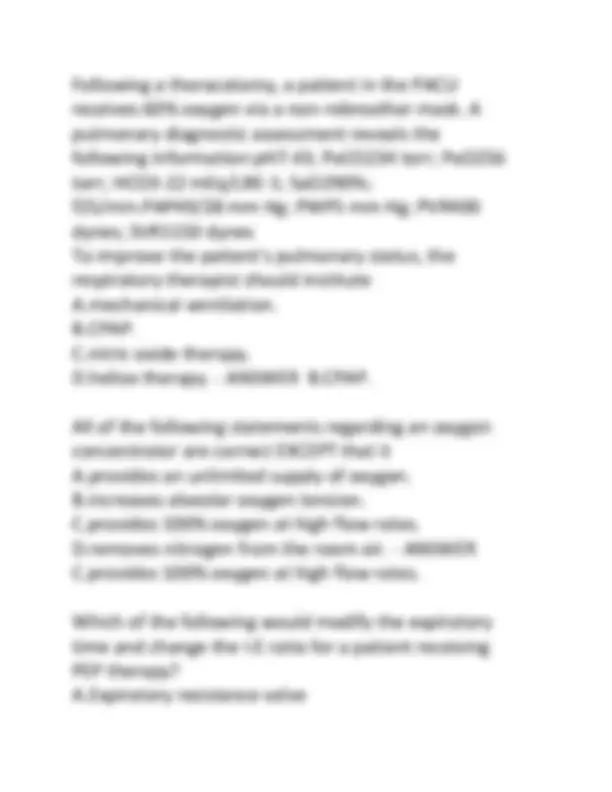
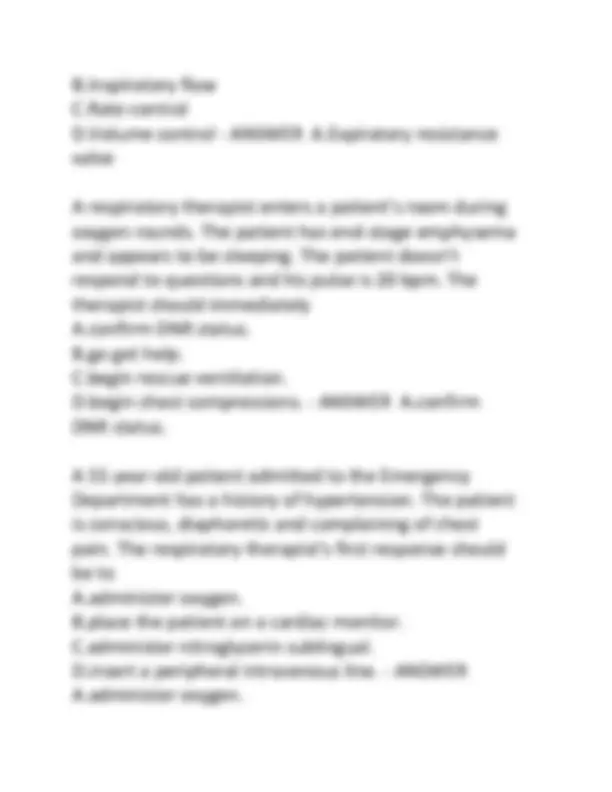
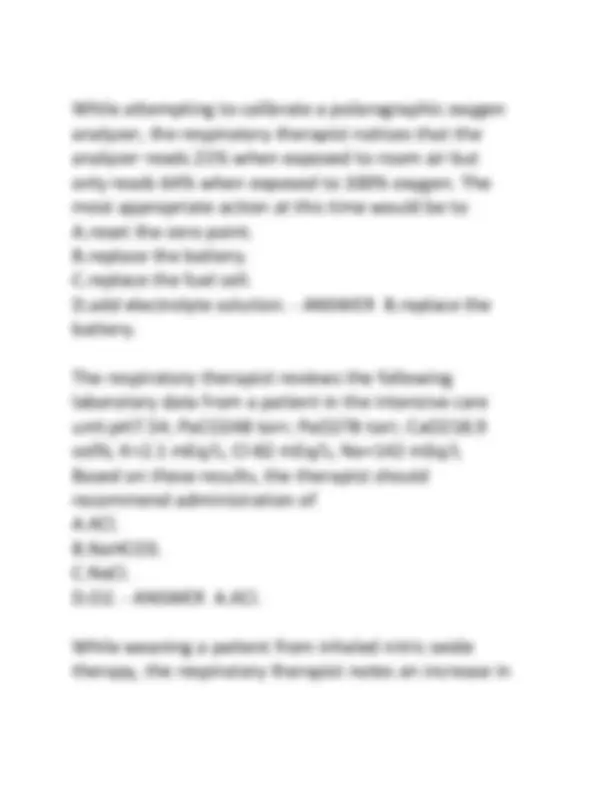
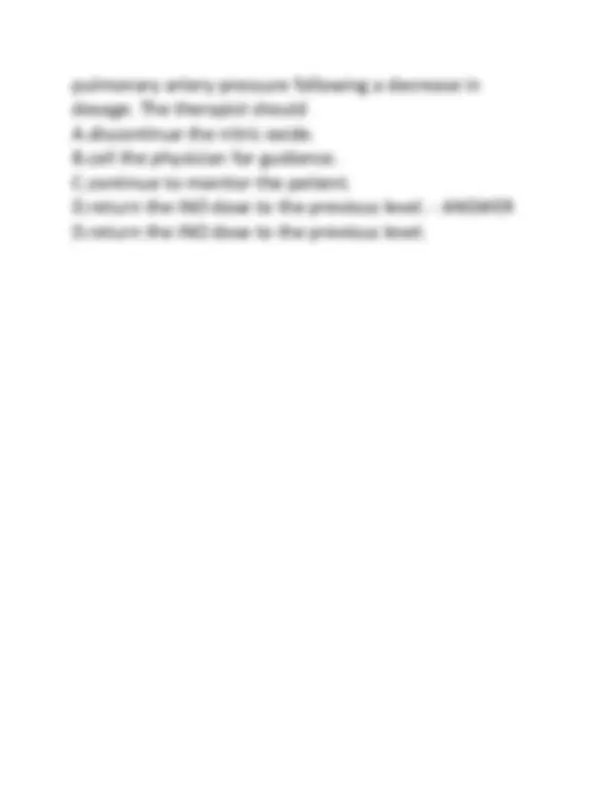


Study with the several resources on Docsity

Earn points by helping other students or get them with a premium plan


Prepare for your exams
Study with the several resources on Docsity

Earn points to download
Earn points by helping other students or get them with a premium plan
Community
Ask the community for help and clear up your study doubts
Discover the best universities in your country according to Docsity users
Free resources
Download our free guides on studying techniques, anxiety management strategies, and thesis advice from Docsity tutors
MC practice exam 2 questions and answers with verifie
Typology: Exams
1 / 69

This page cannot be seen from the preview
Don't miss anything!






























































After a patient undergoes a thoracentesis, the respiratory therapist notes that the obtained pleural fluid is clear with a slight straw color. This fluid is most likely the result of A.empyema. B.congestive heart failure. C.lung carcinoma. D.hemothorax. - ANSWER B.congestive heart failure. Which of the following would be most important to evaluate for a patient who is entering a smoking cessation program? A.Height B.Smoking history C.Weight D.Diet - ANSWER B.Smoking history The respiratory therapist calibrates a spirometer and checks the volume with a 3.0 liter super syringe. The volumes recorded are: 2.85 L, 2.8 L, and 2.8 L. Based upon the information obtained which of the following is a correct statement? A.Another syringe needs to be used B.Spirometer is accurate
C.The plunger was advanced too slowly D.Spirometer may have a leak - ANSWER D.Spirometer may have a leak Which of the following is an indication for high frequency jet ventilation? A.Bronchopleural fistula B.Wilson Mikity syndrome C.Necrotizing lesion of right lung D.Centrilobular emphysema - ANSWER A.Bronchopleural fistula A 43-year-old female patient undergoes a total abdominal hysterectomy. The patient arrives in the Post Anesthesia Care Unit obtunded with minimal response to painful stimulus. What treatment should the respiratory therapist recommend for this patient? A.Initiate assisted ventilation B.Insert oropharyngeal airway C.Obtain positron emission tomography D.Initiate noninvasive capnography - ANSWER B.Insert oropharyngeal airway A 44-week gestational age infant is delivered via C- section and is gasping, grunting, and has tachycardia and tachypnea. At one minute his Apgar score is 4 and
B.right side hyperlucency, absent vascular markings. C.hepatomegaly. D.right lower lobe consolidation with air bronchograms. - ANSWER B.right side hyperlucency, absent vascular markings. A 64-year-old, 70 kg (154 lb) man with severe COPD receives independent (differential) lung ventilation following thoracotomy and right lower lobectomy. Which of the following setting combinations would be most appropriate for this patient? A.Right lung 50 mL; left lung 450 mL B.Right lung 150 mL; left lung 350 mL C.Right lung 250 mL; left lung 250 mL D.Right lung 350 mL; left lung 150 mL - ANSWER B.Right lung 150 mL; left lung 350 mL A patient in the intensive care unit has the following hemodynamic measurements:CVP (mm Hg)5PAP (mm Hg)29/8PCWP (mm Hg)8BP (mm Hg)130/70Cardiac output (L/min)5.1Cardiac index (L/min/m2)2.7What is the pulse pressure? A.15 mm Hg B.21 mm Hg C.60 mm Hg D.90 mm Hg - ANSWER C.60 mm Hg
A 2-year-old child with croup has been intubated for 4 days with a 4 mm ID uncuffed endotracheal tube. Heated aerosol at an FIO2 of 0.30 has been delivered to the patient. The physician asks the respiratory therapist to evaluate the patient for possible extubation. Which of the following would most likely indicate that the patient is ready for extubation? A.The patient is making normal quiet ventilatory efforts. B.A negative sputum culture and sensitivity has been reported. C.The patient's ABG are within normal range. D.Breath sounds are heard around the tube on auscultation. - ANSWER D.Breath sounds are heard around the tube on auscultation. A patient is seen in the Emergency Department for complaints of nausea and vomiting. A nasogastric tube has been inserted and the patient is started on lasix. Which of the following should the respiratory therapist monitor? A.Cardiac enzymes B.Serum electrolytes C.Arterial blood gases D.Cell hydration level - ANSWER B.Serum electrolytes
crackles, +2 pitting edema and a chest radiogram with a butterfly pattern. These results are most consistent with which of the following? A.Pulmonary edema B.Pulmonary interstitial emphysema C.Pneumothorax D.Emphysema - ANSWER A.Pulmonary edema What is the total flow delivered to a patient receiving oxygen via 28% Venturi mask with the oxygen flowmeter set at 6 L/min? A.12 L/min B.24 L/min C.30 L/min D.66 L/min - ANSWER D.66 L/min Fine crepitant crackles are most commonly associated with which of the following conditions? A.Bronchitis B.Pulmonary edema C.Pneumonia D.Foreign body aspiration - ANSWER B.Pulmonary edema A patient with end-stage pulmonary fibrosis receives oxygen at 2 L/min via transtracheal oxygen catheter.
The patient complains of increased work of breathing and shortness of breath. The respiratory therapist should A.manually ventilate the patient with a resuscitation bag. B.increase the flow to the transtracheal catheter to 6 L/min. C.evaluate the SpO2 with a pulse oximeter. D.flush the transtracheal device with saline. - ANSWER D.flush the transtracheal device with saline. During bedside monitoring, the respiratory therapist notices a dampened waveform on the arterial line graphic. To restore the graphic to normal, the therapist should first A.verify the position of the transducer. B.check the transducer dome for air bubbles. C.flush the catheter with heparin solution. D.attempt to draw blood from the arterial line. - ANSWER D.attempt to draw blood from the arterial line. An optimal PEEP study is initiated for a patient receiving mechanical ventilation. The respiratory therapist initiates PEEP of 10 cm H2O for 20 minutes with no adverse effects. The PEEP is increased to 15
sinus bradycardia. What is the most appropriate route to administer atropine to this patient? A.Aerosolized via small volume nebulizer B.Injected via intraosseous route C.Instill into endotracheal tube D.Instill into nasogastric tube - ANSWER C.Instill into endotracheal tube TMC Practice Exam Answers: Question 24 of 160 The results of a patient's spirometry are recorded as follows:PredictedObservedFVC (L)3.52.1FEV (L)2.72.6FRC (L)2.51.7TLC (L)5.64.2These results are indicative of A.normal lung function. B.sarcoidosis. C.acute bronchitis. D.cystic fibrosis. - ANSWER B.sarcoidosis. The respiratory therapist is in charge of transporting a patient with multiple trauma to a regional trauma center in a fixed wing aircraft. Which of the following should the therapist be most concerned about during the transport? A.Tissue oxygenation B.Pneumothorax C.Pulmonary embolus
D.Humidification of the inspired gas - ANSWER A.Tissue oxygenation Transcutaneous monitoring of PO2 values will correlate well with arterial blood gas PO2 values in which of the following situations?1. Hypotension2. Hypothermia3. Pneumonia A.1 only B.3 only C.1 and 2 only D.2 and 3 only - ANSWER B.3 only The respiratory therapist evaluates the following data for a patient receiving mechanical ventilation in the intensive care unit:ModeVC, SIMVMandatory rate b/minTotal rate18 b/minVT800 mLFIO20.60PIP31 cm H2OPEEP10 cm H2OpH7.41PaCO240 torrPaO torrSaO296%HCO3-23 mEq/LBE+1 mEq/LPECO torrHb15 g/dLWhat should the therapist report as the VD/VT ratio? A.15% B.25% C.40% D.50% - ANSWER B.25%
C.12 French D.14 French - ANSWER B.10 French Which of the following would be the most appropriate test to evaluate partial vocal cord paralysis in a patient complaining of difficulty swallowing? A.SB nitrogen elimination B.Maximum voluntary ventilation C.Flow volume loop D.Diffusing capacity - ANSWER C.Flow volume loop In order to reduce a patient's PaCO2 from 40 torr to 32 torr, all of the following could be increased EXCEPT A.tidal volume. B.alveolar ventilation. C.respiratory rate. D.physiologic deadspace. - ANSWER D.physiologic deadspace. While examining the chest drainage system of a mechanically-ventilated patient following thoracotomy, the respiratory therapist observes bubbling in the water-seal chamber during inspiration. This would indicate A.a leak in the chest drainage system. B.air leaving the pleural space.
C.excessive pressure from the suction regulator. D.inadequate water level in the water-seal chamber. - ANSWER B.air leaving the pleural space. A patient develops ascites and shortness of breath. Where is tissue edema most likely to show up first? A.Ankles B.Abdomen C.Thorax D.Hands - ANSWER B.Abdomen An acceptable level of PEEP therapy can be identified by all of the following EXCEPT A.the lower inflection point of a volume-pressure loop graphic. B.acceptable oxygenation without cardiovascular side effects. C.increasing oxygenation with increasing plateau pressure. D.increasing static compliance with acceptable oxygenation. - ANSWER C.increasing oxygenation with increasing plateau pressure. While suctioning a patient being mechanically ventilated, the respiratory therapist notes the presence of multiple premature ventricular
D.hypovolemia. - ANSWER B.pulmonary hypertension. A patient with a flail chest is intubated and mechanically ventilated with PEEP therapy. Pancuronium bromide has been administered. Which of the following ventilator alarms would be most important to set correctly for this patient? A.Peak pressure alarm B.Low pressure alarm C.I:E ratio alarm D.Low exhaled volume alarm - ANSWER B.Low pressure alarm A balloon-tipped, flow-directed catheter is positioned in the pulmonary artery with the balloon deflated. Which of the following pressures will be measured by the distal lumen? A.CVP B.PAP C.PCWP D.MAP - ANSWER B.PAP Which of the following assessments should the respiratory therapist recommend for a patient at high risk for post-operative complications?
A.VD/VT study. B.Diffusion studies. C.Bedside spirometry. D.Indirect calorimetry. - ANSWER C.Bedside spirometry. A patient receives noninvasive positive pressure ventilation by mask. Current settings and arterial blood gas results are as follows:I PAP10 cm H2O EPAP5 cm H2ORespiratory rate12 /minpH7. PaCO256 torr PaO263 torr HCO327 mEq/L BE+3 mEq/LWhich of the following should the respiratory therapist recommend? A.Increase the EPAP to 10 cm H2O B.Decrease the EPAP to 3 cm H2O C.Increase the IPAP to 15 cm H2O D.Decrease the IPAP to 5 cm H2O - ANSWER C.Increase the IPAP to 15 cm H2O During recovery from resection of an aortic aneurysm, a 65-year-old female patient suddenly develops severe substernal chest pain with grave dyspnea. The physician describes the bilateral breath sounds as
D.YesNoYes A. B. C. D. - ANSWER A A 30-year-old male who weighs 68 kg (150 lb) has a minute ventilation of 9 L/min. and a respiratory rate of 20/min. What is his alveolar minute volume? A.4 L/min. B.6 L/min. C.8 L/min. D.12 L/min. - ANSWER B.6 L/min. During a cardiopulmonary stress test on a 55-year-old man, the respiratory therapist notes the following changes:
D.administer amiodarone. - ANSWER A.continue the test. The respiratory therapist receives an order to administer bronchodilator therapy with albuterol. To reduce the chance of cross contamination, the therapist should A.select a metered dose inhaler. B.utilize a dry powder inhaler. C.replace the small volume nebulizer every 24 hours. D.wipe the surface of the nebulizer with alcohol every evening. - ANSWER A.select a metered dose inhaler. Which of the following is a FALSE statement about self-inflating resuscitation devices? A.A reservoir is utilized to increase the delivered oxygen concentration. B.The respiratory therapist can sense changes in the patient's lung compliance and airway resistance. C.A compressed gas source is necessary for the device to operate. D.Excessive gas flow may cause the valve to malfunction. - ANSWER C.A compressed gas source is necessary for the device to operate.